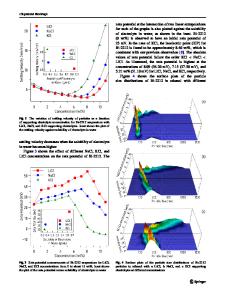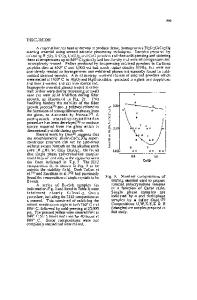Phase Chemistry and Micro-Structure of Directionally Solidified Bi 2 Sr 2 CaCu 2 O 8
- PDF / 933,452 Bytes
- 4 Pages / 420.48 x 639 pts Page_size
- 78 Downloads / 356 Views
PHASE CHEMISTRY AND MICROSTRUCTURE OF DIRECTIONALLY SOLIDIFIED Bi 2Sr 2CaCu 2 O8 H.M. CHOW', X.P. JIANG', M.J. CIMA*, J.S. HAGGERTY', H.D. BRODY**, M.C. FLEMINGS* *Massachusetts Institute of Technology, Department of Materials Science and Engineering, Cambridge, MA 02139 "*University of Pittsburgh, Department of Materials Science and Engineering, Pittsburgh, PA 15261
ABSTRACT Ceramic rods of Bi 2Sr 2CaCu 2 Os (2212) were directionally solidified by laser-heated float-zone crystal growth [1]. The microstructure of the resulting material can be controlled through variation of growth rate. The 2212 phase is Sr-deficient, having an actual composition Bi 2.5 Sr 2 CaCu 2.2O,. At slow growth rates (0.2 cm/h), plane front growth produced highly textured samples of almost phase pure 2212, and pole figures show that the solidification front proceeds along the (200) axis of the 2212 grains. Faster growth rates produced dendritic growth and polyphase microstructures. At the fastest growth rate studied (16 cm/h), no 2212 phase was observed. Observations indicate that Bi 2.sSr 2CaCu 2.20 melts peritectically into (Sri-.Ca,)14Cu2 4Oy and a Bi-rich liquid. INTRODUCTION The ability to carry large amounts of current is an important property of bulk superconductors. Conventional processing methods produce granular superconducting material with low critical current density (J,), and grain boundaries are known to be the cause of this weak-link behavior [2]. Processing methods that eliminate or minimize the effect of grain boundaries are therefore desired. The laser-heated float-zone method was selected for several reasons. Jin et al. [3] have demonstrated that aligned microstructures of YBCO produced by melt processing exhibit high J, values. Laser-heated melt processing of superconductors has been demonstrated by Takekawa [4], Feigelson [5], and by our preliminary studies [6]. This method is attractive because detailed knowledge of the phase diagram is not needed to produce steady state growth; the melt adjusts itself, subject to the thermodynamic constraints, such that the composition of the solidifying boule is the same as the composition of the feed rod. The method is also crucible free, allowing growth without complications arising from reactions with other components in the system.
EXPERIMENTAL PROCEDURE Feed material for float-zone growth were sintered rods having a 2212 composition. Powders of Bi 2 0 3 , SrCO 3 , CaCO 3, and CuO were ball milled in deionized water with zirconia balls as grinding media. The powder was dried, calcined in 02, granulated, and poured into rubber tubular molds. Cold pressed 4.7 mm diameter and 150 mm long rods were sintered at 780'C in 02 for 6 h. Heating of the molten zone was achieved using four orthogonal laser beams directed onto the rod. Crystal growth was carried out under 2.75 atmn 02, with the feed rod and solidifying boule rotated in opposite directions. Typical rotation rates were 50 rpm. Mat. Res. Soc. Symp. Proc. Vol. 169. ©1990 Materials Research Society
314
Growth was carried out i
Data Loading...











